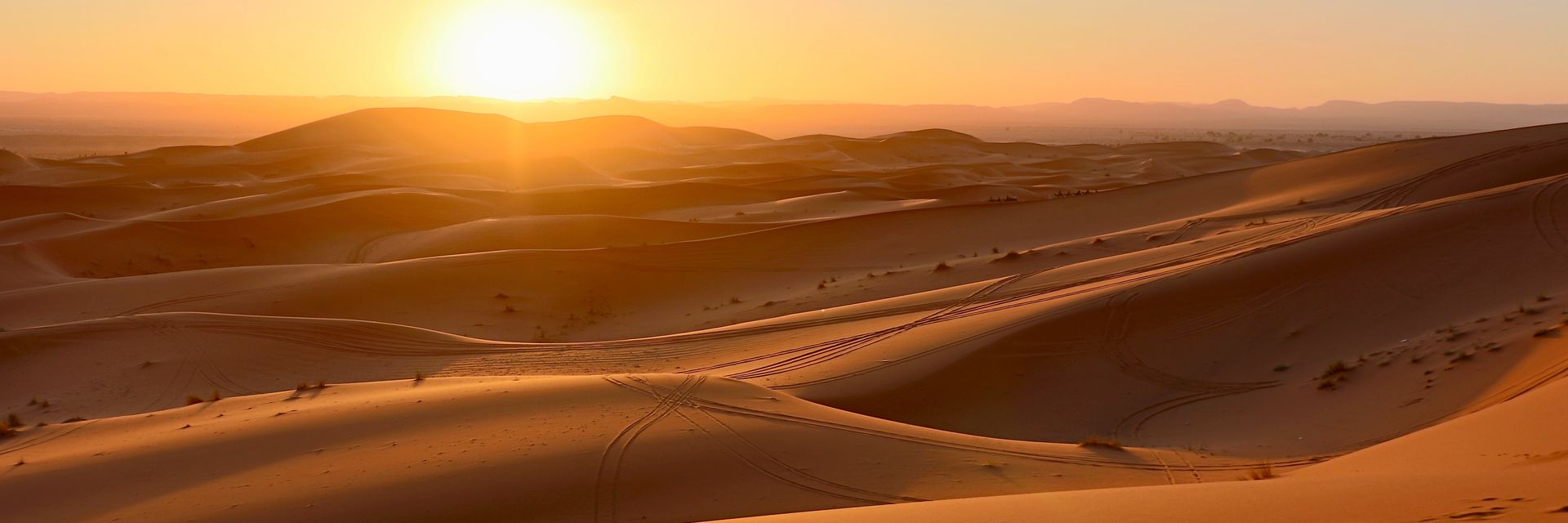As one of the world’s hottest deserts, the Sahara seems to be an inhospitable expanse of sand and rock. But life persists there, showcasing species with spectacular adaptations.
◊
Envision an endless sea of sand. Each day, the punishing sun beats down on any living thing caught in this barren world. There is little relief here – water sources are few and far between, and shade is a luxury that cannot be found for many miles. Wicked, swirling sandstorms are frequent, disorienting animals and people, and making navigation impossible. This is the reality of life in the Sahara.
It might not be the largest desert in the world (that distinction goes to Antarctica), but it stretches across all of North Africa. And, once upon a time, this enormous desert was completely unidentifiable – in fact, it wasn’t even a desert at all.
Experts disagree about when it was formed, but the Sahara was once a sprawling expanse of vegetation and life, supported by an abundance of life-sustaining water. With time, most of the precipitation in the area disappeared, transforming a once lush landscape into the vast desert that we know today.
Animals and plants of the region were tested by this shift, forcing them to adapt or die. Those that have succeeded have undergone astounding adaptations in order to carry on in one of the harshest habitats the world has to offer.
To explore the precarious niche living things have found in the Sahara Desert, watch "Sahara: Life on the Edge," an episode ofMagellanTV's Wildest Africa.
Adaptable Sahara Desert Animals
The Sahara desert is home to many extraordinary animals, ranging from mammals to reptiles, insects, and even birds. Desert animals have evolved efficient behaviors to conserve water. For example, to cope with extreme temperature fluctuations, these animals employ strategies like being active at night and seeking shade or burrowing during the hottest parts of the day. They’ve also adapted their feeding behaviors in a resource-scarce environment, with some being carnivorous, insectivorous, or herbivorous.
Here are three of the Sahara’s most resilient residents:
Addax
Scientific name: Addax nasomaculatus
Average lifespan: 19 years
Conservation status: Critically Endangered
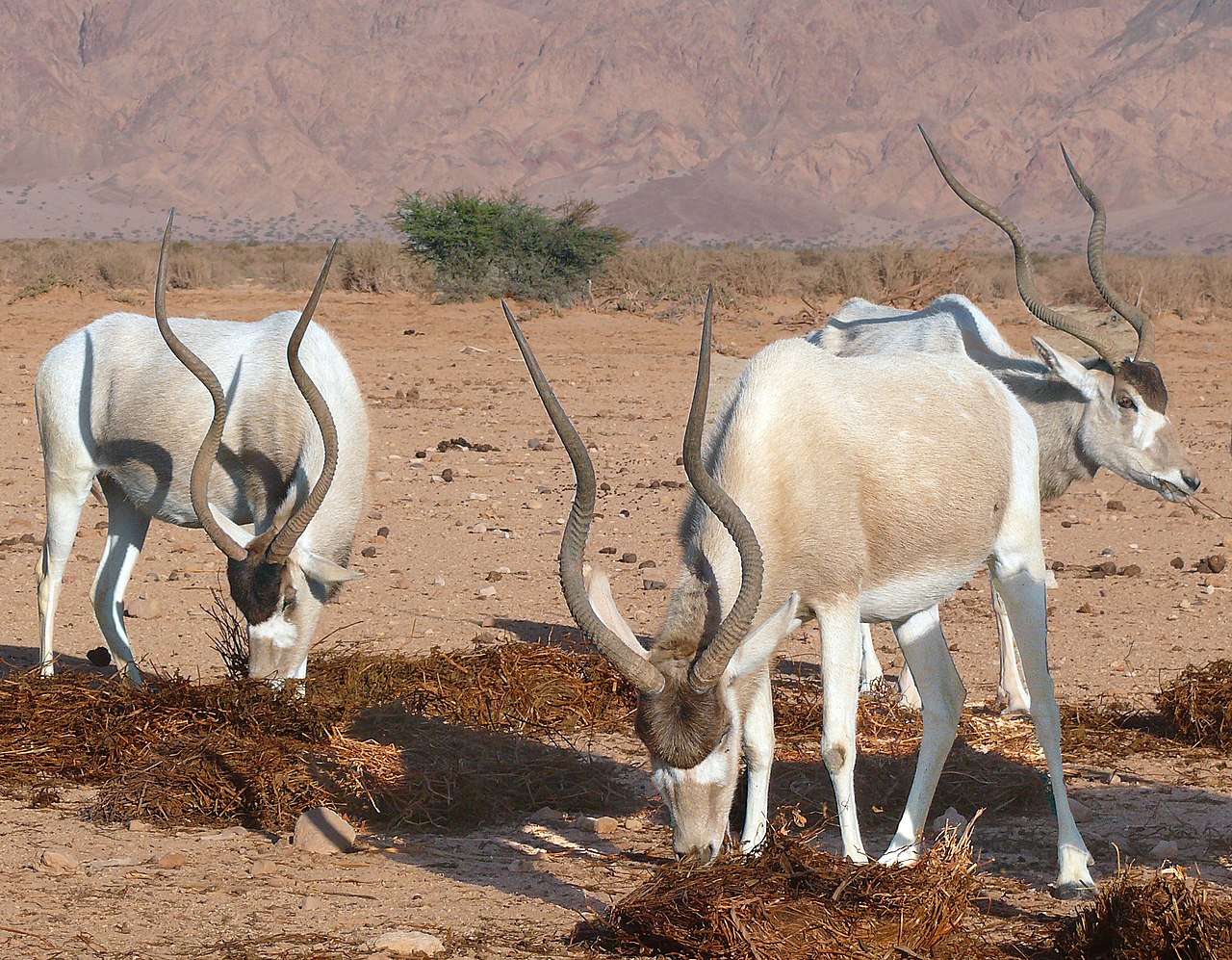
Three addaxes grazing (Credit: Zachi Evenor, via Wikimedia Commons)
Addaxes are an antelope species that are most active at night to escape the fierce heat of the day. They are known for their intricate twisted horns that can reach up to two and a half feet long! These incredible animals have undergone many adaptations that allow them to withstand the unforgiving desert conditions of the Sahara. Because water is hard to come by in the desert, addaxes have adapted to live without it for long periods of time, and often rely on their diet of grass and leaves as their main water source. These antelopes also conserve the water they take in by producing incredibly concentrated urine. In the summer, addaxes can be found sporting a white or blonde coat, which helps them reflect the intense radiant desert heat to stay cool. Despite their remarkable adaptations, experts believe that fewer than 500 individuals are left in the wild today.
Fennec Fox
Scientific name: Vulpes zerda
Average lifespan: 10 years
Conservation status: Least Concern
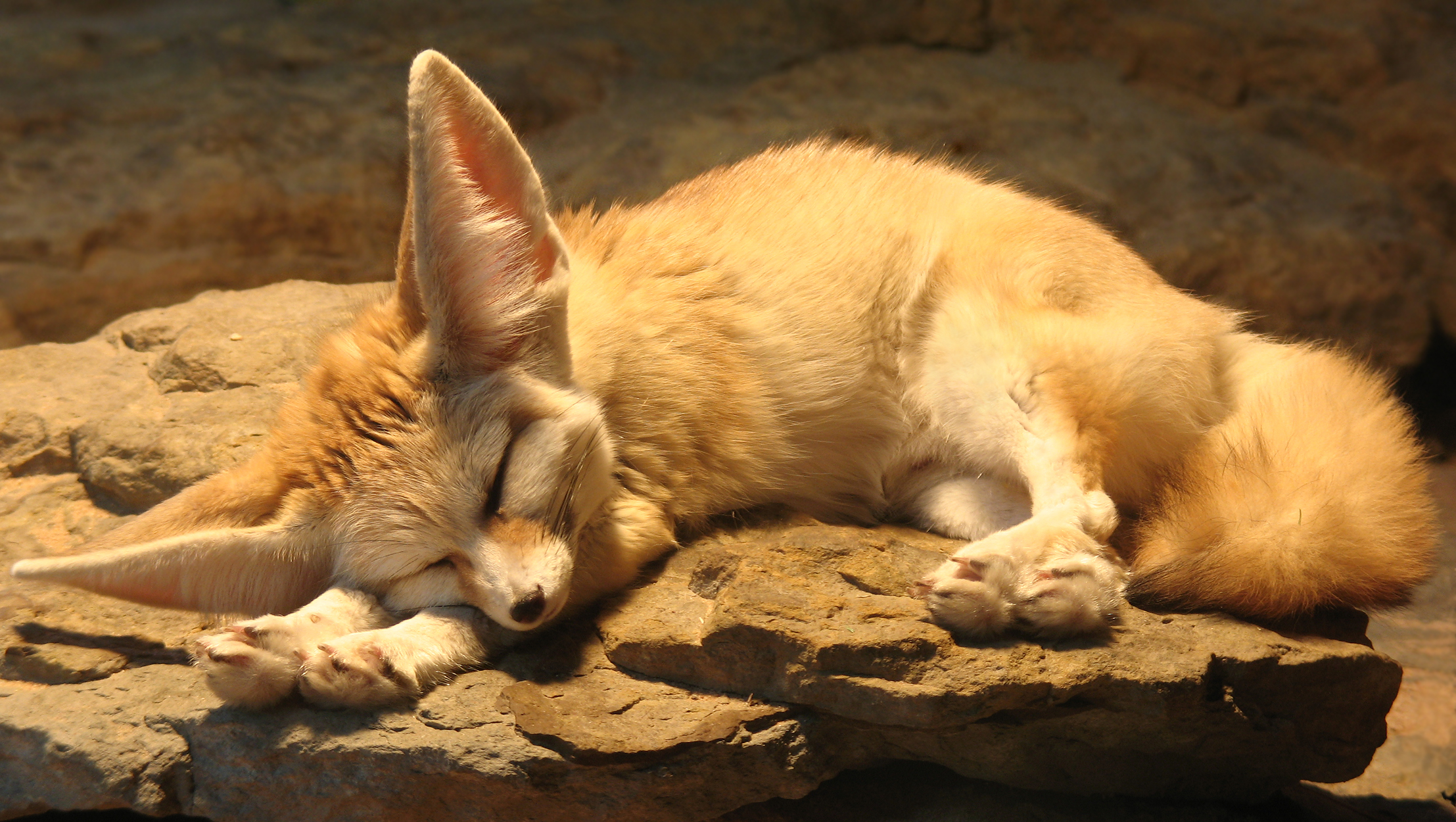
A Fennec fox taking a nap on a rock (Credit: Wildfeuer, via Wikimedia Commons)
Weighing up to around three and a half pounds, fennecs are not only the smallest fox, but also the smallest canids. These tiny foxes are most active during twilight, and have sandy colored fur that reflects sunlight to keep them cool and allows them to camouflage with the sand. Though their astonishingly large ears may seem to exist just for beauty, they are actually crucial to the fennec’s ability to locate prey as well as to dissipate heat. Inhabiting underground burrows also helps them escape the relentless sunrays. Fennec foxes survive on a robust menu consisting of plants, insects, and small reptiles and rodents. They have adapted to manage without water for extended periods of time, and their main water source comes from the food that they eat.
Saharan Silver Ant
Scientific name: Cataglyphis bombycina
Average lifespan: Unknown
Conservation status: Unknown
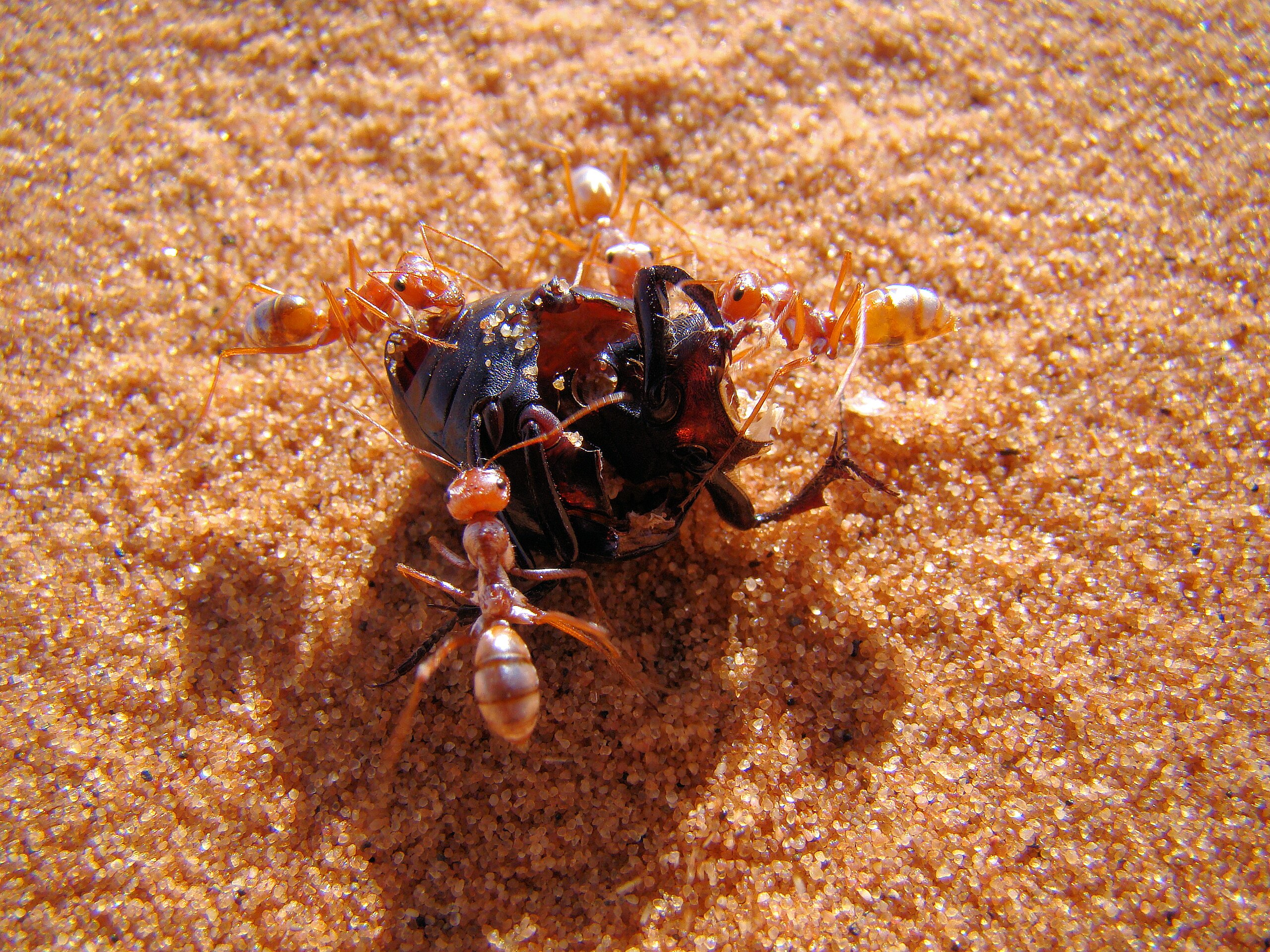
Saharan silver ants taking a beetle to their nest (Credit: Bjørn Christian Tørrissen, via Wikimedia Commons)
Simply put, Saharan silver ants are record-breaking overachievers. Not only are they one of the most heat tolerant land animals in the world, but of all the 12,000 ant species they are the fastest, traveling their body length 108 times per second! However, their speed is just one of their many adaptations to the desert. Saharan silver ants spend as little time outside of their nest as possible to escape the heat and predators. In fact, they average only ten minutes per day in the open, which is made possible by their speed and precise navigation using the sun. These ants also produce heat shock proteins prior to departure from their nest, in anticipation of extreme temperatures that would be lethal otherwise. Also protecting them are triangle-shaped hairs that cover their bodies, allowing them to dissipate heat through thermal regulation.
Resilient Sahara Desert Plants
Although the Sahara receives less than three inches of rainfall per year, many plant species are able to survive in these arid conditions. Desert plants have water-efficient features such as succulent tissues and deep root systems. In addition, they have sunscreen-like adaptations and heat-tolerant enzymes. To ensure survival and reproduction in arid conditions, the plants use seed dormancy and efficient pollination methods.
Here are three of the toughest:
Colocynth
Scientific name: Citrullus colocynthis
Conservation status: Unknown
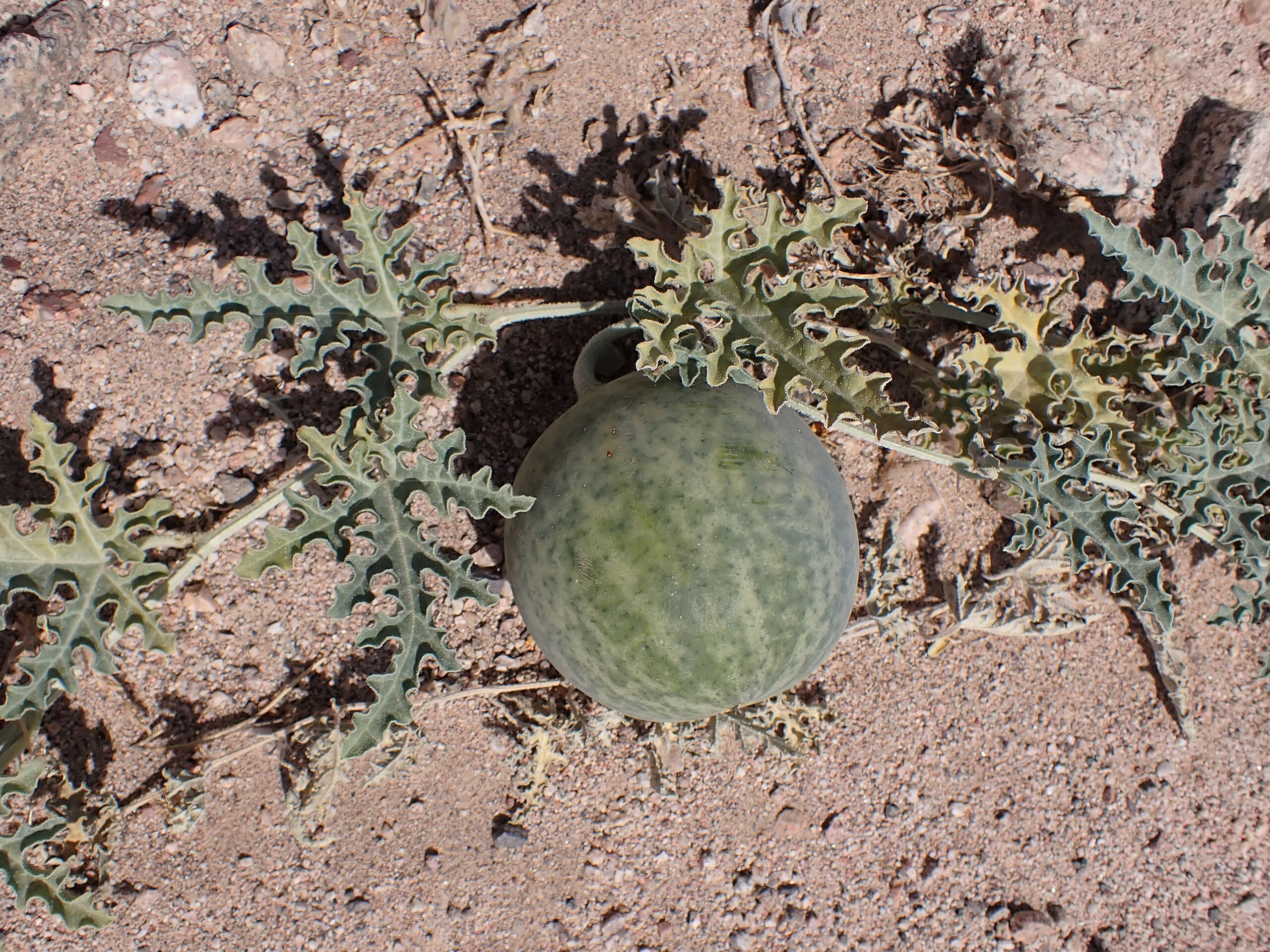
A colocynth bearing fruit (Credit: Krzysztof Ziarnek, via Wikimedia Commons)
Colocynth are vine-like plants which produce bitter fruit that are small and firm. These hearty plants can withstand the arid conditions of the Sahara desert with the help of their thick and fleshy roots. The roots are perennial, meaning that they can survive perpetually throughout the seasons. It is also believed that, in intense heat, these plants increase their rate of transpiration through their leaves to cool down.
Saharan Cypress
Scientific name: Cupressus dupreziana
Conservation status: Endangered

Cones of a Saharan cypress (Credit: Consultaplantas, via Wikimedia Commons)
The Saharan cypress can live for more than 2,000 years and can be found in the mountains of central Sahara. These amazing long-living trees are coniferous, and can tower up to 72 feet (22 meters) tall. Despite their mammoth size, the Saharan cypress can survive on just over an inch (30 mm) of annual rainfall. Remarkably, this species reproduces asexually, utilizing only male genes carried in pollen, without any genetic input from the female. Unfortunately, there are only 233 Saharan cypress trees still alive today.
Athel Tree
Scientific name: Tamarix aphylla
Conservation status: Unknown
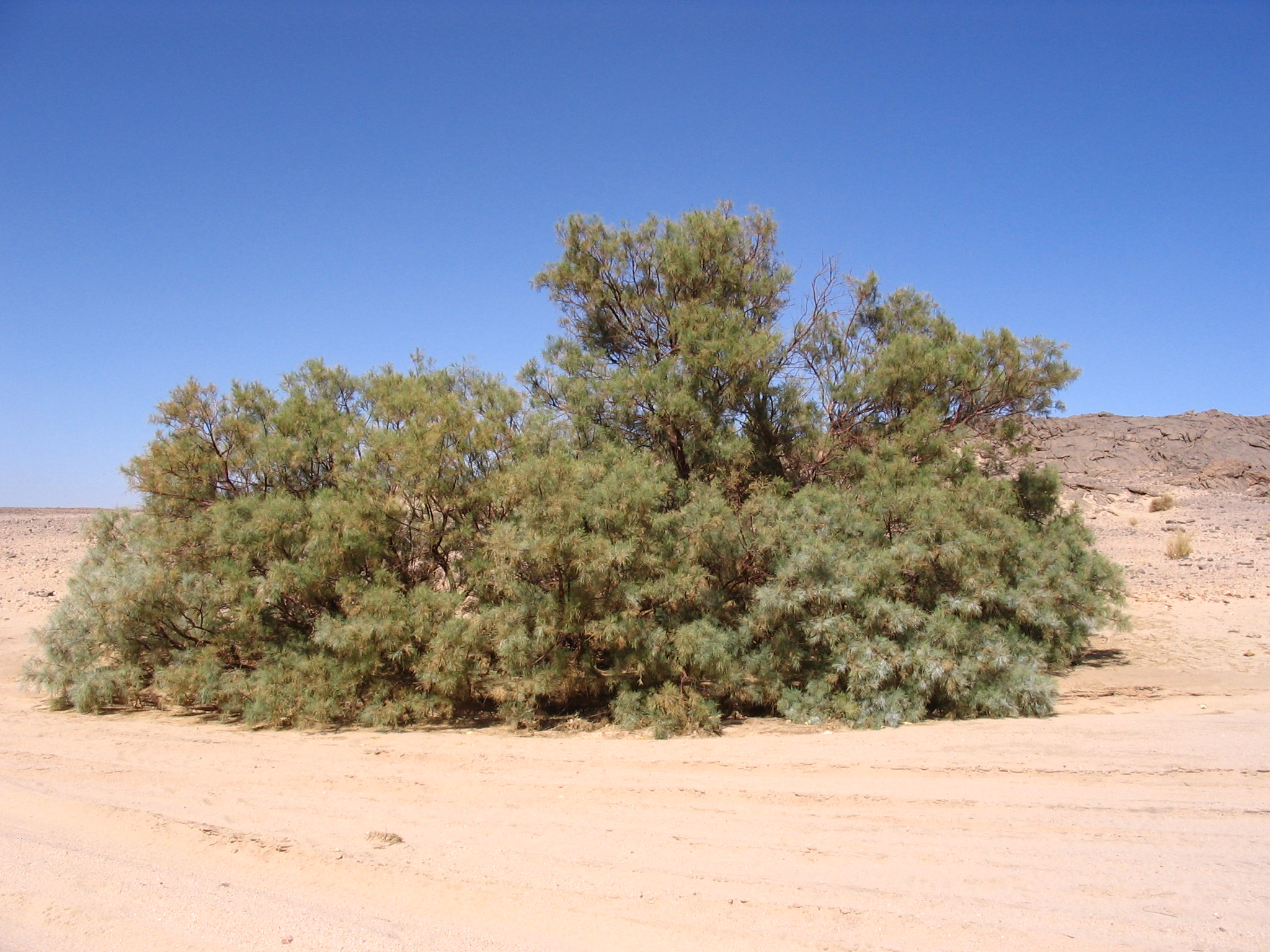
Athel tree in Algeria (Credit: Anthere, via Wikimedia Commons)
Athel trees are found alongside watercourses that cut through the Sahara. They are incredibly tolerant of saline and alkaline soils, and can even withstand up to 15,000 ppm of salt. In fact, their small leaves ooze with salt, so much so that they are often crusted over with crystals. The leaves are also peculiar due to their arrangement along the branches of this species. And, as deciduous trees, athels keep their unique leaves all year round.
Want to Learn More About the Sahara Desert?
If these incredible species have piqued your interest and you’d like to learn more about the Sahara and its inhabitants, watch MagellanTV’s documentary “Sahara: Life on the Edge.”
Ω
Maggie Williard is a contributing writer for MagellanTV. She recently graduated from Kenyon College, where she studied biology. She works in public relations and lives in New Jersey.
Title Image credit: Matt, via Unsplash
